The cruise report from the 2021 cruise to the Aurora vents is ready!
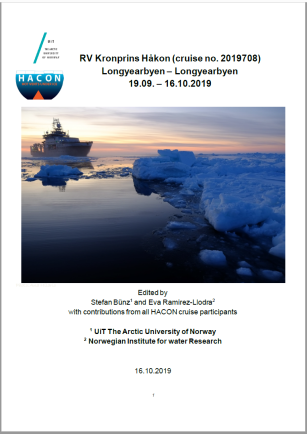

It has been 2 weeks since we came back from our cruise to the Gakkel ridge and finally we are catching up with everything that was put on hold for 4 weeks. During the cruise, we were away from mobile phone range and the only internet we had was via Iridium satellite to be used only for simple text messages. We did not see any other vessels or people during all this time, and we really felt far away from everything!
In this blog, you can read a short summary of some of the most exciting moments on board. And you can also read the nice story written by Nadia Drake, based on her own observations and very interesting discussions with the scientists on board: “If alien life exists in our solar system, it may look like this” by Nadia Drake, contributing writer at National Geographic.

The icebreaker Kronprisn Hakon on her way to the Aurora vent field.
The Aurora vent field that we went to investigate is on the Gakkel ridge, in the Arctic Ocean, at 83.5°N and 4000 m depth on a seamount. The first black smokers ever to be observed in the Arctic were discovered during the Polarstern expedition PS86 led by Prof Antje Boetius (AWI, Germany), with the scientists from AWI being key partners in the HACON project and cruise. The Gakkel Ridge region, at this time of the year, is covered by large ice floes slowly drifting (most of the time at 0.2-0.4 knots) with incredible force. The ocean temperatures under the ice are below zero and the terrain on the seafloor is complex, with steep sides of the seamount, active black smokers on the top, sink holes…All this poses challenges and demands on technology and crew are huge. This was a high-risk, high-gain type of expedition. Anything could go wrong. But any new observations and samples would greatly increase our understanding of these exotic ecosystems. And we had it all!
Thin and thick ice around Aurora.
We had technological issues, but these only fueled extremely interesting new collaborations amongst the engineers from WHOI, AWI and NASA-JPL. So much as to build, from spare parts, a mini, deep-diving ROV that could go down to 4000 m attached on OFOBS (Ocean Floor Observation and Bathymetry System, AWI), giving OFOBS the capacity to “look” around, instead of only below its frame from its down-looking camera. This little ROV was called Sponge Bob Spare Parts.
The happy team from Kronprisn Haakon, AWI, WHOI and NASA-JPL that built Sponge Bob Spare Parts, adn the mini-ROV being deployed with OFOBS for its first test dive.
We face the challenge of non-collaborative ice floes that would drift on top of the Aurora vent site limiting our access to it. But the excellent team on the bridge of the Kronprins Haakon and the cruise lead (with a lot of patience too!) found ways of getting us on station. Several times, the Aurora vent site “came out” under a large lead of open water or thin ice between ice floes, and we were ready on station at the right time, where we could operate our deep-diving equipment safely.
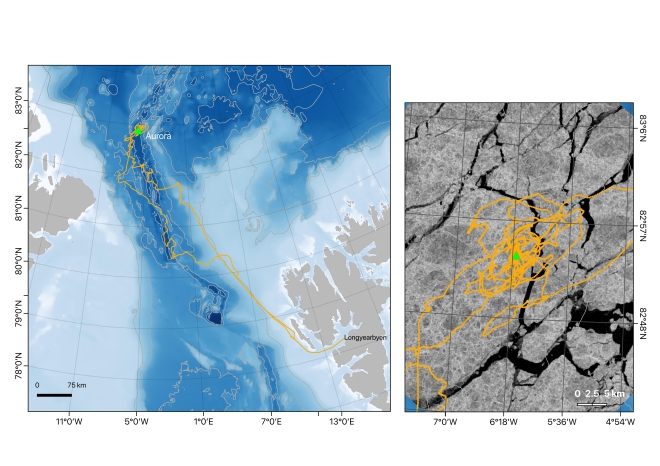 Map showing the route of the Kronprins Haakon from Svalbard to the Aurora vent field and back, with the detailed sailing and drifting around Aurora shown over an satellite image of ice. The large dark areas show the large leads of open water or thin ice where we could dive and sample safely.
Map showing the route of the Kronprins Haakon from Svalbard to the Aurora vent field and back, with the detailed sailing and drifting around Aurora shown over an satellite image of ice. The large dark areas show the large leads of open water or thin ice where we could dive and sample safely.
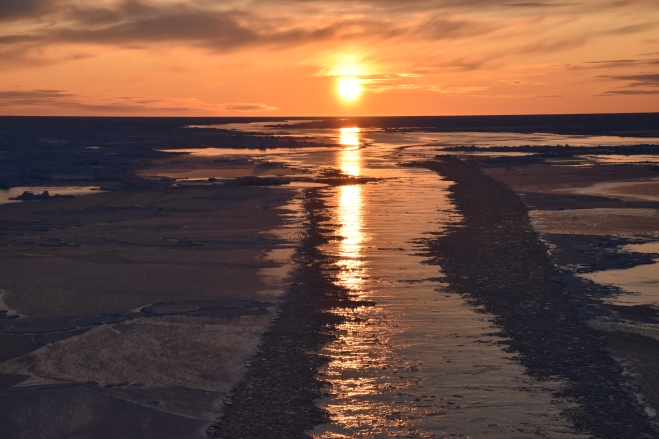
Sunset over a large open lead between two ice floes.
One of the best days of the cruise was the first dive of the towed OFOBS system over the vent site… or should I say through the vent, as OFOBS climbed and climbed the sulphide mound as we slowly drifted towards the vent field…and suddenly we saw the “smoke”… and seconds later we were in the black smoke, which is hydrothermal fluid at 350°C. The camera feed was gone for what seemed like a very long couple of minutes. But after that, the seafloor came back into view. We were back in business!
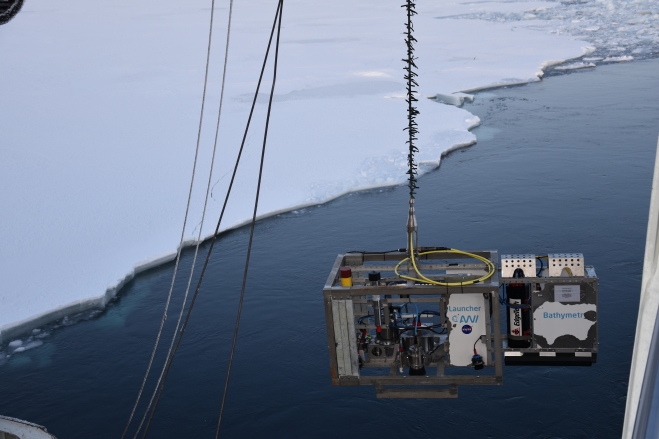
OFOBS (AWI) being deployed to survey the Aurora vent field.
After this exciting OFOBS dive, we managed several dives more over the vent field, providing a unique data set of videos and high-definition photographs with a lot of new information on the Aurora vents. At least 2 new black smokers have been observed, one of them particularly large.

Seafloor habitat on the Aurora sulphide mound approaching the vent field, showing one of the active black smokers observed during OFOBS dives on the Aurora seamount. Photo: OFOBS/AWI team.
We also had many interesting OFOBS dives around the seamount, showing the variety of habitats in the region, from soft sediment with rocks colonised by sponges and associated fauna, sinkholes, basalt rocks, rusty soft and coarse sediments as we climb the sulphide mounds. The systematic analyses of the many hours of OFOBS videos will provide a detailed image of what the Gakkel ridge and its fauna looks like, greatly increasing our understanding of the region. The OFOBS data will be complemented with a wealth of samples taken around the seamount, with our coring systems and the ROV NUI, that will help us understand the processes driving the Aurora seamount communities, from the viruses and microbes all the way to the sponges that thrive in this region.
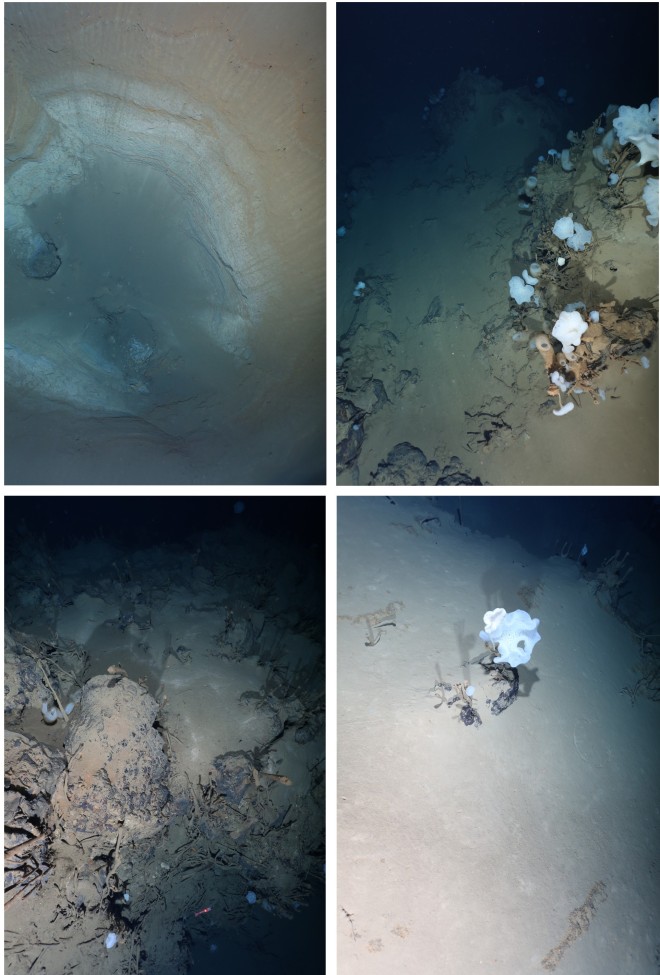
Common benthic communities observed during OFOBS dives on the Aurora seamount, showing a sink hole, live sponges and dead sponge stalks on basalt rocks. Photos: OFOBS/AWI team.

The hybrid ROV/AUV NUI (WHOI) being deployed.
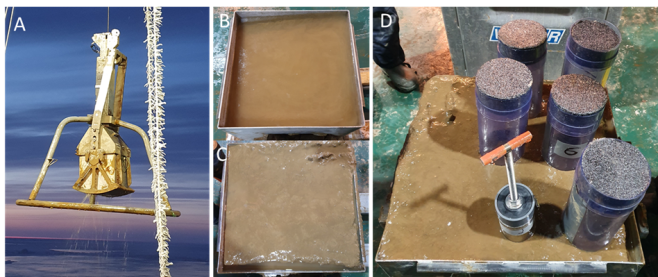
Sediment samples from the Aurora seamount, collected with the boxcore and subsampled with tubes from the multicore (Images from Hans Tore Rapp).
There were eleven scientific institutions represented on the cruise, with main focus on life in ice-covered oceans. Ecology, micropaleontology, oceanography, geochemistry, you name it we had it on board. But astrobiology was a completely new topic for many of us and we were delighted to have NASA-JPL with us! Together with UiT, National Geographic and Avatar Alliance Foundation, the NASA-JPL team worked on the ice, taking ice-core samples to investigate if biogeochemical signatures from the Aurora vent field might be found in the overlying ice, and if any vent microbes may be found there. The results will contribute to the planning of future projects that aim at exploring for life in other frozen oceans, such as the ones found on Europa (Moon of Jupiter) or Encedalus (moon of Saturn). We also had a drone on board (from UiT), that worked both for science – investigating sea-ice mapping potential – and communication – producing amazing images of the Kronprins Haakon and people working on ice.
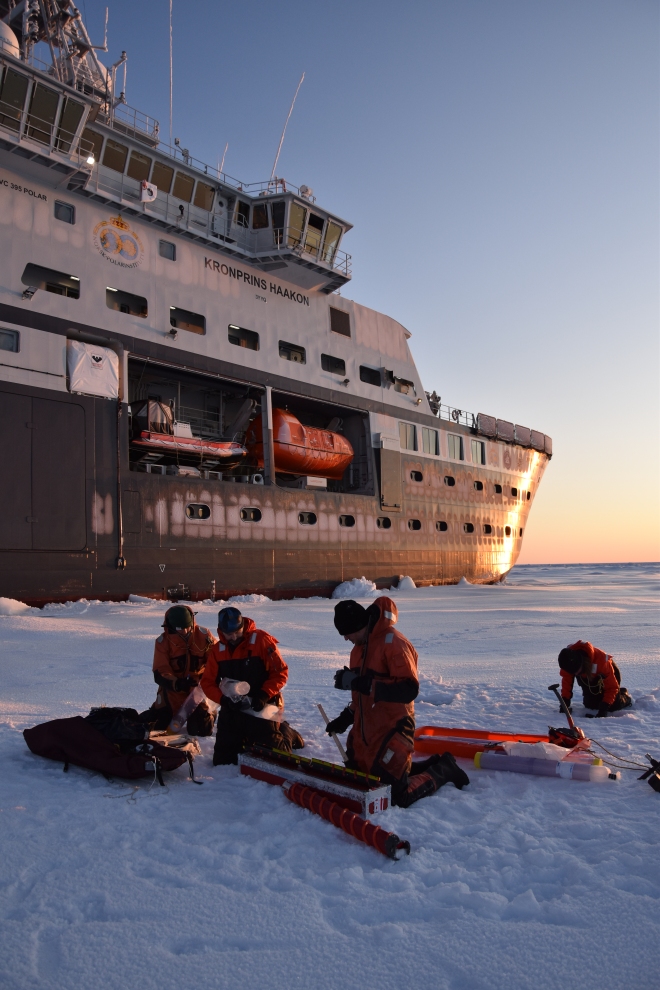
Ice coring with Kronprisn Haakon “parked” on the side of the ice floe.

Sampling thin ice from one of the small boats.
As co-leads of the cruise, Stefan and I are extremely happy on how the cruise developed and what we achieved. In addition to the scientific success of the cruise, the atmosphere on board was extremely positive. Samples in such complex cruises with so many partners can be scarce, but from the start all samples were shared, to ensure all teams had samples. Knowledge was also shared openly, making this cruise a great learning experience as well. Existing collaborations have been strengthened and new ones have started, which will result, without a doubt, in new joint activities within HACON and new scientific and engineering projects in the future.
The atmosphere on board was also boosted by the excellent crew on board Kronprins Haakon. Captain Karl Robert and his officers, Leif Christian and Jim, where always ready to assist us in reaching the elusive vents around the drifting ice, often with help from the vessel’s engines to break non-collaborative ice! The crew made all our operations on deck and on the ice easy and safe – in addition to taking gorgeous photos of the cruise! And the galley team took so good care of us that it felt like going to a restaurant at every single meal … almost no one could avoid the 3 o’clock cake time, where many interesting ideas where discussed and plans made!
The HACON cruise was high-risk, and we did have challenges. But it was, without a doubt, high-gain as well. We already know much more about the Aurora vent field than we did a month ago and as the sample and data analyses progresses in the labs of all the partners, a fuller picture will emerge of the composition and functioning of this remote and pristine ecosystem.
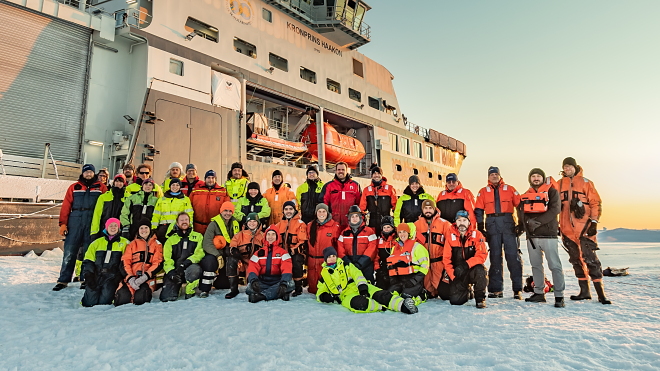
The HACON team towards the end of the cruise, before leaving the ice. Photo: Aleksander Eeg, R/V Kronprins Haakon.
10 October 2019 – 82° 53’N, 06° 15’W
Last year, the kids in the 3rd grade at Billingstad school (Norway) learnt about the Dumbo octopus. The beautiful drawings they made can be seen in the HACON “Outreach” web page.
Just before we left for the cruise, my daughters Ine (3rd grade) and Nia (4th grade) gave a presentation to their classmates and teachers in Billingstad school about the deep sea, hydrothermal vents and the HACON cruise. I could not be a prouder mum as I listened to them, and it was so nice to see the 7-9 year old school kids so engaged listening and asking interesting questions.
One of the things Ine and Nia talked about was how pressure increases as we go deeper in the ocean. To illustrate this, we have done an experiment: the kids wrote their names and drew on polystyrene cups, which we then took to the bottom of the ocean to the Aurora seamount. The high pressure shrinks the cups into mini-cups, and in this photo you can see the result!
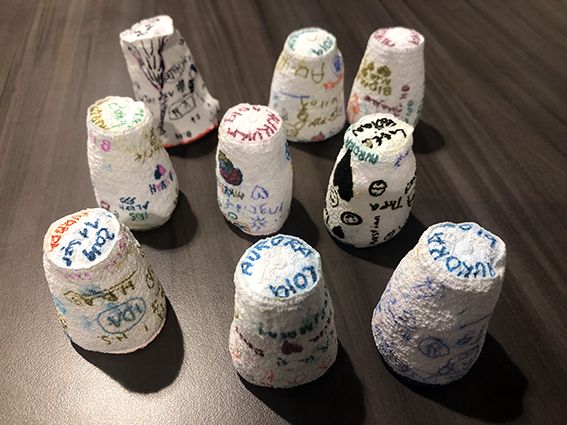
We have a little surprise too…! During the seafloor camera surveys, we had seen the octagonal marks that the Dumbo octopuses leave on the soft mud when they eat. And then, a couple of days ago, we caught on camera a Dumbo octopus eating on the seafloor! Well, we only saw 3 of its tentacles…but it was nice to see!

8 October – 82° 53’N, 06° 15’W
Life on board is mostly about doing science, but a month on board cannot be just work. Both scientists and crew members need to rest and enjoy their free time. One of the highlights every day on board RV Kronprins Haakon, are the 3 delicious meals served 3 times per day by the great galley team of Kenneth, Anne Kristine, Monica and Åse. And it does not end there: there is cake time (every day!) at 3, which is difficult to avoid when the sweet smells of freshly baked cake or waffles expand around the vessel. In addition to the gorgeous meals, there is a bit of everything for everyone in terms of entertainment.
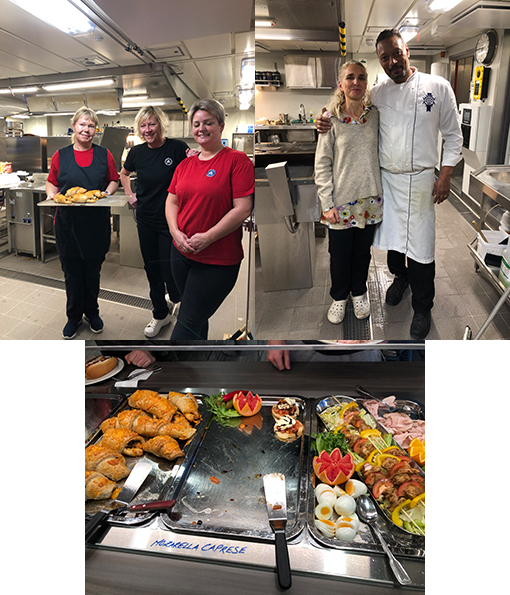
Until now, we had a fun pub quiz, some movie nights and the twister competition organized by Anne Kristine where everyone gets together in the lounge demonstrate their flexibility and strength. Board games are also popular, but there is also time for reading or knitting quietly in the library looking out to the beautiful sunset over the arctic ice.
Some people like going to the gym alone, others prefer to enjoy the “outdoors” group activities, which include two sets of 7 min workout in the helicopter hanger (a.k.a. “Choppers gym”) with 3 sets five-lap runs around the helicopter deck – a freezing but fun experience. And a ping pong tournament is being organized by the ping pong queen Ana. And if someone needs some relaxation after a stressful day or long hours of working with mud on deck or the cold room, there is always a message chair, a sauna and a jacuzzi, that are also popular.

Personally, one of the most fun things I have done some far was going for a walk on ice, and hopefully we can do this again before we leave the ice 🙂

Written by Sofia Ramalho, Uni. Aveiro.
03 October – 82° 53’N
13:37 on board Kronprins Haakon over the Gakkel Ridge. Today, the ice drift is collaborating with us and with some calculations and good planning from the bridge, we deploy OFOBS (Ocean Floor Observation Bathymetry System) for video and bathymetry transects over the Aurora vent field. Our vent hunting is guided by the vent position provided by Antje Boetius (AWI), obtained during her discovery cruise on-board the Polarstern in 2014. Flying over the vent with OFOBS might sound easy, but there are some obstacles that we have to overcome first….
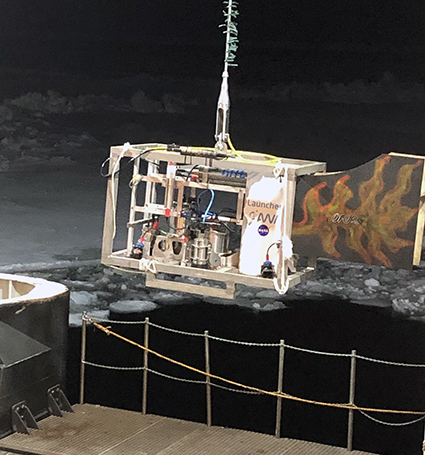
But today we get lucky: we are at the edge of a large lead with open water and thin ice surrounding the ice floe currently covering the Aurora vent field. The drift will take us over the vent site, so by hanging on the edge of the ice (instead of getting stuck in the ice with no maneuverability) there is a possibility of slowly moving the 100 m and 10 thousand tonnes of the RV Kronprins Haakon to try to get the camera of OFOBS to capture the Aurora black smokers.
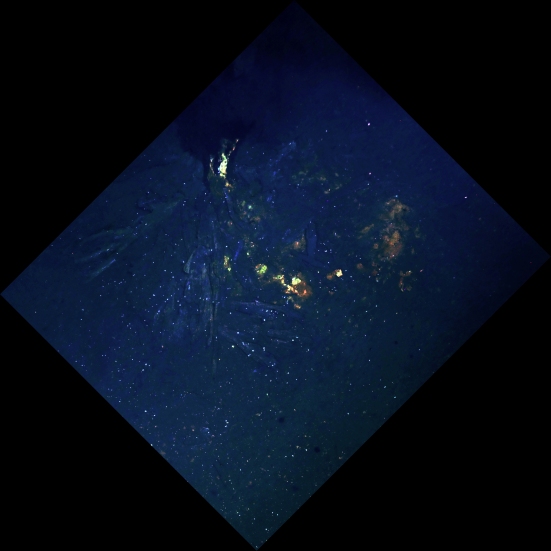
A black smoker at the Aurora vent field. Photo: OFOBS team, AWI.
As we approach the vents, the scientists gather across multiple screens – the tiny winch room, where OFOBS is controlled from, proves to be a hotspot with 16 people stuffed in 4m2, while the conference room has more people annotating what we see on the seafloor. The enthusiasm is touchable, and when the first vent makes its first appearance, we explode in cheers and hugs. With a tiny field of view, it is evident that we located a needle in a haystack. In fact, the drift carried us right through the black smokers with OFOBS being quite the champion by capturing the plume with its camera lens. For many of us, it is the first time we have the opportunity to see such exotic and dynamic systems “face to face”, in their full glory, pouring huge quantities of black smoke out from the depths. In total we managed to capture the beautiful vent fields on camera over several occasions and many scientists reported back goosebumps. All in all, this was a day full of success stories, a lot of luck and one that most of us will never forget.